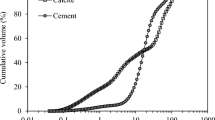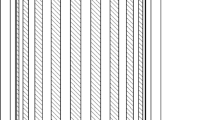Abstract
A smart cement-based magnetorheological (MR) fluid, one that could be tailor-designed to yield the desired rheological properties of cement paste, in real time is presented. By incorporating magnetic particles inside the cement paste and by varying the magnitude of the magnetic field strength, the rheological response of the sample is altered significantly. This cement-based MR fluid would allow for better control over stiffening/setting behavior of concrete and can be useful in applications in which controlling the fresh-state behavior of concrete is critical. In this work, magnetic fields were altered in a low-high-low and high-low-high pattern to assess the effect of cyclic variations of the magnetic field on the rheological behavior. It was found that a cement-based MR fluid does exhibit field sensitivity in its rheological behavior when the magnetic field is varied. At early ages, when the magnetic field is varied, the rheological behavior was seen to be less dependent on the time frame at which the magnetic field is applied and more related to the magnitude of the magnetic field. At later ages, in the presence of a cyclic magnetic field, the rheological response will be influenced by the magnetorheological response and by aging mechanisms (e.g., hydration and thixotropy) that impact the stiffening of cement paste.








Similar content being viewed by others
References
ACI-237 (2007) Self consolidating concrete. Farmington Hills, MI
API-10A (2011) Specification for cements and materials for well cementing. Washington, DC
Ashtiani M, Hashemabadi SH, Ghaffari A (2015) A review on the magnetorheological fluid preparation and stabilization. J Magn Magn Mater 374:716–730
ASTM-C150 (2012) Standard specification for Portland cement. West Conshohocken, PA
ASTM-C1738 (2011) Standard practice for high-shear mixing of hydraulic cement pastes. West Conshohocken, PA
Banfill PFG (2003) The rheology of fresh cement and concrete—a review. In: Grieve G, Owens G (eds) 11th International Congress on the Chemistry of Cement. Durban, pp. 50–62
Billberg P, Khayat KH (2008) Use of viscosity-modifying admixtures to enhance robustness. Proceedings of the Third North American Conference on the Design and Use of Self-Consolidating Concrete
Bury MA, Christensen BJ (2002) Role of innovative chemical admixtures in producing self-consolidating concrete. First North American Conference on the Design and Use of Self-Consolidating Concrete
Coey JMD (2009) Magnetism and magnetic materials. Cambridge University Press, Cambridge, UK and New York
Daczko JA (2012) Self-consolidating concrete: applying what we know. CRC Press, Boca Raton, FL
Deshmukh S (2007) Development, characterization and applications of magnetorheological fluid based ‘smart’ materials on the macro-to-micro scale. Dissertation, Massachusetts Institute of Technology
Emborg M, Jonasson JE, Nilsson M, et al. (2005) Designing robust SCC for industrial construction with cast-in-place concrete. Proceedings of the Fourth International RILEM Symposium. Chicago, IL, pp. 1251–1259
Ferraris CF, Guthrie W, Avilés AI, et al. (2006) Certification of SRM 114q: part II (particle size distribution). NIST Special Publication 260–166. Technology Administration, U.S. Department of Commerce
Ferron RD, Gregori Z, Sun Z, Shah SP (2007) Rheological method to evaluate structural buildup in self-consolidating concrete cement pastes. ACI Mater J 104:242–250
Ferron RD, Shah SP, Fuente E, Negro C (2013) Aggregation and breakage kinetics of fresh cement paste. Cem Concr Res 50:1–10
Gartner EM, Young JF, Damidot DA, Jawed I (2002) Hydration of Portland cement. In: Bensted J, Barnes P (eds) Structure and performance of cements. Spon Press, New York, pp. 57–113
Goodier C (2003) Development of self-compacting concrete. Proceedings of the Institution of Civil Engineers: Structures and Buildings. pp 405–414
Han D, Ferron RD (2015) Effect of mixing method on microstructure and rheology of cement paste. Constr Build Mater 93:278–288
Jarl J (2012) Cement mill sheet, Texas-Lehigh Plant, Buda, Texas
Jiang SP, Mutin JC, Nonat A (1995) Studies on mechanism and physico-chemical parameters at the origin of the cement setting. I. The fundamental processes involved during the cement setting. Cem Concr Res 25:779–789
Klingenberg DJ, Olk CH, Golden MA, Ulicny JC (2010) Effects of nonmagnetic interparticle forces on magnetorheological fluids. J Phys Condens Matter 22:324101
Larson RG (1998) Structure and rheology of complex fluids. Oxford University Press, USA
Nair SD (2013) Adaptive performance of cement-based materials using a magnetorheological approach. University of Texas at Austin, PhD Dissertation
Nair SD, Ferron RD (2014) Set-on-demand concrete. Cem Concr Res 57:13–27
Nelson EB, Guillot D (2006) Well cementing, (2nd ed). Schlumberger, Sugarland, Texas
Phulé PP (2001) Magnetorheological (MR) fluids: principles and applications. Smart Mater Bull 2001:7–10
Red R (2009) Refraction of Light http://interactagram.com/physics/optics/refraction/. Accessed 10 Jul 2012
Rich JP, Doyle PS, McKinley GH (2012) Magnetorheology in an aging, yield stress matrix fluid. Rheol Acta 51:579–593
Roussel N, Ovarlez G, Garrault S, Brumaud C (2012) The origins of thixotropy of fresh cement pastes. Cem Concr Res 42:148–157
Wallevik JE (2009) Rheological properties of cement paste: thixotropic behavior and structural breakdown. Cem Concr Res 39:14–29
Acknowledgments
The authors thank the following suppliers for donating materials: Texas Lehigh (cement) and BASF (magnetic particles).
Author information
Authors and Affiliations
Corresponding author
Rights and permissions
About this article
Cite this article
Nair, S.D., Ferron, R.D. Real time control of fresh cement paste stiffening: Smart cement-based materials via a magnetorheological approach. Rheol Acta 55, 571–579 (2016). https://doi.org/10.1007/s00397-016-0923-x
Received:
Revised:
Accepted:
Published:
Issue Date:
DOI: https://doi.org/10.1007/s00397-016-0923-x




